“. . . from so simple a beginning endless forms most beautiful and
most wonderful have been, and are being, evolved.”
Charles Darwin
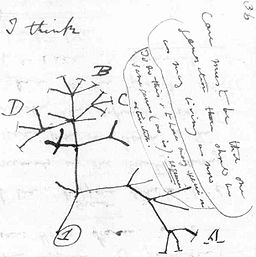
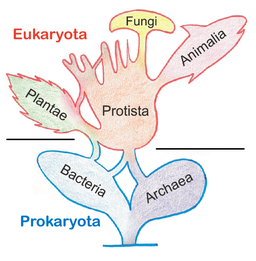
A few of you may recognize the story told in my first blog. I have told it before. On the surface, this story describes my first nocturnal venture into the tropical rainforest of Southeast Asia. But, of course, I really intended for it to mean more than that. I related the tale for three reasons. First, it is my belief that the natural world offers us limitless opportunities for learning, wonder, pleasure, and fulfillment. These opportunities give us the chance to indulge in self-reflection, accumulate knowledge, escape from world-weariness, and provide a pathway to understanding our place in the world. Such activities are particularly human ones. Indeed, I would argue that these types of mental gymnastics are what set us apart from other species. We may be members of the animal kingdom but it appears that we are exceedingly special animals in this respect.
Secondly, it seems that both anecdotal and experimental evidence now suggest that contact with the natural world is vital for the psychological health of humans. For millennia, it was the natural world – the rainforest, the prairie, the desert – that provided the environments within which our human proclivity for curiosity, inventiveness, contentment, and meaning were satisfied. Achieving these desires brings us a sense of satisfaction and happiness. They make our life whole and purposeful.
And finally there is this – the big-picture idea – to consider. It is now apparent, after five-hundred years of progress in science, that the world in which we live is part of an astonishing, I would even say miraculous, emergent process. I have long wondered why is there is something rather than nothing in the first place? If all we know has emerged from nothing, what is this “nothing”? Was it the absence of space? The absence of time? These are questions that have occupied the minds of scientists and philosophers alike for a good while. Whether the question is valid or what the answer to this enigmatic query might be (if one is possible), one fact seems clear. From a state of virtual nonexistence has materialized a world of incredible complexity and biodiversity. Some will disagree with my belief that cosmic and biological evolution have direction. Others will accuse me of making a leap of faith. Still, I would argue that the evolution of the universe, and subsequently earth’s biodiversity, do display both purpose and direction. From the spawning of the first simple element hydrogen, emerged the stars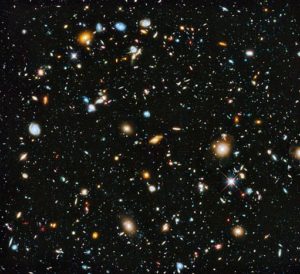 that populate the billions of galaxies of our universe. From some of these stars, the elements that, so far as we know, comprise all matter were then generated. The calcium in our bones, the nitrogen in our DNA, the gold filling in our tooth, all these have been forged from the titanic forces generated by exploding stars. Once formed, the elements have yielded molecules and compounds which have made possible the evolution of life itself. From the first primitive cells, whose precise origins are lost in the vapors of time, have arisen all of the organisms, simple to complex, which have graced the earth.
that populate the billions of galaxies of our universe. From some of these stars, the elements that, so far as we know, comprise all matter were then generated. The calcium in our bones, the nitrogen in our DNA, the gold filling in our tooth, all these have been forged from the titanic forces generated by exploding stars. Once formed, the elements have yielded molecules and compounds which have made possible the evolution of life itself. From the first primitive cells, whose precise origins are lost in the vapors of time, have arisen all of the organisms, simple to complex, which have graced the earth.
Over its four and one-half billion year history, our planet itself has undergone extreme emergent geologic change. From its molten origins has come a world of rock, soil, air, and water. As a boy, exploring the waste from the numerous underground coal mines near my home in southwestern ![]()
![]() Indiana, I found evidence (in the form of bivalves and crinoids ) that the
Indiana, I found evidence (in the form of bivalves and crinoids ) that the  land I now walked upon was once the bottom of a sea. Further east the Appalachians had risen to snow-capped heights rivaling the Rockies. Over the eons, the ravages of wind, water, and ice have reduced them to their present aspect of rounded, rolling domes – the Smoky Mountains. The very continents themselves, we now know, wander restlessly over the earth’s mantle. Viewed from space, the visage of earth today is very different than when the dry lands were merged to form the immense super-continent known as Pangaea.
land I now walked upon was once the bottom of a sea. Further east the Appalachians had risen to snow-capped heights rivaling the Rockies. Over the eons, the ravages of wind, water, and ice have reduced them to their present aspect of rounded, rolling domes – the Smoky Mountains. The very continents themselves, we now know, wander restlessly over the earth’s mantle. Viewed from space, the visage of earth today is very different than when the dry lands were merged to form the immense super-continent known as Pangaea.
Within the realm of living matter, the emergent complexity and increasing biodiversity we see is perhaps even more remarkable. The ancient archaea and bacteria, their simple cells lacking even a nucleus, first arose billions of years ago. Soon they inhabited the soil, water, and rocks of the earth. Seemingly no habitat was too extreme and even the hot springs and salt lakes teem with these so-called extremophiles in their untold numbers. Then the more complex nucleated protists, the algae and the protozoans took their place upon life’s stage. The algae began the first tentative movements of life onto the dry land. These colonizers in turn gave rise to the primitive plants, such as the mosses, and eventually to complex autotrophic organisms such as the cone-bearing and flowering plants. The latter group, owing to their great biological success, clothed the earth with photosynthetic greenness. Their leaves, pollen, and nectar provided sustenance for a vast assemblage of heterotrophic species and thus triggered an evolutionary explosion of diversity within the animal kingdom.
With my apologies to plant lovers, I now follow the trail to the animal kingdom. From animal-like protozoans extended a pathway to the jellyfishes, corals, and sea anemones. Even today, their stinging-cell armed descendants constitute the cnidarians which swarm the seas of the world and build the limestone bulwarks we call reefs. Some six hundred million years past the multitudinous and varied realm of the worms emerged onto the ancient scene. Flatworms crept through marine and fresh waters. Many of their descendants became adapted to a parasitic lifestyle and comprise the fascinating clans of the flukes and tapeworms. Roundworms filled the soils of Earth in their millions. The segmented worms too found their places in both the aquatic and terrestrial abodes of the world. Today they reside as marine tubeworms, earthworms that till the soil of your lawn, and the sanguivorous leeches. Mollusks, in their remarkable and diverse forms from squid to snail, began to swim, crawl the sea bottoms, and to probe into the dark, moist places of terra firma. That great assemblage of animal species known as the arthropods appears in the fossil record some five hundred and forty million years past. They claimed their portion of the aquatic environments of the world in the shape of shrimp, crab and lobster. In the guise of centipede and scorpion, spider and insect the arthropods also came to be the dominate invertebrates of the dry lands of the planet. Today nearly one million species of insects alone are known to science. The echinoderms, the spiny-skinned starfish and urchins, in their rich variety dispersed themselves through the earth’s vast oceans. Descendants of this group became the ancestors of the fishes which eventually claimed dominion over the waters of the world. From one group of ancient fish antecedents came the audacious back-boned creatures which first climbed from the water and into the forbidding world of air and sun. Thus, the first amphibians evolved some four hundred million years ago. Over the next three hundred million years there emerged the reptiles, the birds, the mammals. For over one hundred and fifty million years, the dinosaurs reigned as the dominant group of terrestrial vertebrates.
the arthropods also came to be the dominate invertebrates of the dry lands of the planet. Today nearly one million species of insects alone are known to science. The echinoderms, the spiny-skinned starfish and urchins, in their rich variety dispersed themselves through the earth’s vast oceans. Descendants of this group became the ancestors of the fishes which eventually claimed dominion over the waters of the world. From one group of ancient fish antecedents came the audacious back-boned creatures which first climbed from the water and into the forbidding world of air and sun. Thus, the first amphibians evolved some four hundred million years ago. Over the next three hundred million years there emerged the reptiles, the birds, the mammals. For over one hundred and fifty million years, the dinosaurs reigned as the dominant group of terrestrial vertebrates.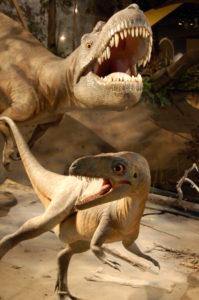 The sudden extinction of the dinosaurs allowed birds, descendants of theropod dinosaurs, to take a turn as the most biologically successful of vertebrates. They were joined in this new world order by the mammals, themselves descended from reptilian ancestors known as synapsids.
The sudden extinction of the dinosaurs allowed birds, descendants of theropod dinosaurs, to take a turn as the most biologically successful of vertebrates. They were joined in this new world order by the mammals, themselves descended from reptilian ancestors known as synapsids.
It isn’t just the emergence of such varied and abundant forms which astounds me. It must be remembered that none of these organisms exist in isolation. We have also seen the emergence of a hierarchy, like a set of nested boxes, of interrelationships. Organisms form populations, populations give rise to communities. Communities and their nonliving environment have been organized into ecosystems. Ecosystems comprise the biosphere, the thin living shell which surrounds the earth and within which all life is found. The interactions within the ecosystems of the world are complex and varied in the extreme. So much so that even today, in the twenty-first century, we cannot claim anywhere near complete understanding of all their workings. British poet Francis Thompson must have intuitively sensed this when he wrote “All things . . . hiddenly connected are. That thou canst stir a flower without troubling of a star.” All this from a great mass of hydrogen spawned from a Nothingness.
Among the mammals, one group was special. The hominids, with their tremendously developed cerebral hemispheres, rose to prominence. Within this group was a modern species known as Homo sapiens – us. And here, after fourteen billion years of evolutionary progress, a true miracle occurred. . With the appearance of humans, the universe has now, finally, at last become able to contemplate its own evolutionary history. We are, as Carl Sagan so aptly put it, “stardust contemplating the stars”. I find this revelation fulfilling. It is the antithesis of the argument that life is purposeless. Can miracle be too strong a word for what has occurred? In an online dictionary, I find the word miracle defined as: a highly improbable or 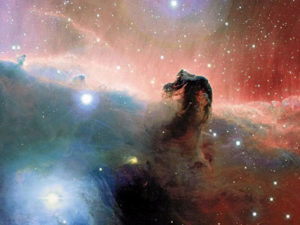 extraordinary event . . . that brings very welcome consequences. In my contemplation of life on earth, this seems to fit what has happened. I find the mere fact of my own existence, let alone the plethora of earth’s organisms past and present, extraordinary. I certainly consider the wondrous biodiversity of our planet a welcome consequence. It is vanity I suppose that compels me to also consider my own existence a welcome consequence of the unfolding universe story.
extraordinary event . . . that brings very welcome consequences. In my contemplation of life on earth, this seems to fit what has happened. I find the mere fact of my own existence, let alone the plethora of earth’s organisms past and present, extraordinary. I certainly consider the wondrous biodiversity of our planet a welcome consequence. It is vanity I suppose that compels me to also consider my own existence a welcome consequence of the unfolding universe story.
In the end, our world and its origins and its complexities, still provides puzzles and enigmas aplenty. As I have aged, I have found myself somewhat more willing to acknowledge that perhaps this big brain of ours isn’t really big enough after all. Like a little Commodore 64 that has been asked to solve a complex problem in celestial mechanics, our brain simply isn’t up to the task of totally comprehending the immense mystery and splendor of the cosmos. Charles Darwin had the following to say about our contemplating the enigmas of the universe. “I feel most deeply that the whole subject is too profound for the human intellect. A dog might as well speculate on the mind of Newton.”  Darwin was correct about a good many things. Perhaps he was in this case also.
Darwin was correct about a good many things. Perhaps he was in this case also.
And so, I must be content for now with the idea that one of our most important purposes in life is simply to engage with and appreciate the living world around us. I have previously voiced my congruence with Alfred Russel Wallace who offered this simple foundation for achieving meaning in our lives. Said he, “Can we believe that we are fulfilling the purpose of our existence while so many of the wonders and beauties of the creation remain unnoticed around us?” And there are wonders at every turn. We should marvel at the beauty and humbling immensity of Orion, faithful companion Canis Major at his heel, as they wheel through the blackness of the winter sky. We ought to find our breath taken away by the flash of a blue morpho’s wings as it wheels through the rainforest understory. We should stand awestricken before the spectacle that is a giant sequoia. Perhaps we cringe, but we should also ponder with admiration the exquisite relationship of parasite and host, of predator and prey. We should marvel at the little ruby-throated hummingbird that has traveled a thousand miles to once again find the feeder we have proffered. We ought to stand in amazed meditation as wave after wave of sandhill cranes descend, on parachute-like wings, into their marshland roost. All of these phenomena are part and parcel of the Universe story. So are we.
We know so much more than our great-grandparents did. We now understand that the very deoxyribonucleic acid which carries our genetic code represents an immortal thread. Our DNA embodies a strand that is a shared lifeline stretching back through the temporal history of the evolution of life on earth. We now appreciate that we have DNA sequences that are communal, not just with other humans, but with most other life forms on this planet. Perhaps this is why the natural world, given the chance, can be such a wellspring of joy, contentment, entertainment, and meditation. We are hard-wired into interrelationships with other species. The natural world is our world, our home, our birthplace.
This is why I consider the opportunities for emotional, psychological, and spiritual wholeness provided by contact with nature to be treasures of rare and lasting value. This is why I feel myself compelled to unabashedly jump with both feet into my experiences in nature. I want to see the earth through the stalked eyes of fiddler crab, imagine the world through the super-senses of bird and bat, to feel the tug of tide and pole. Like Leopold, I envy the muskrat lying eye-deep in a marsh, eavesdropping on the loquacious geese. I want to follow Thoreau’s advice and suck the marrow from nature’s bones. I want to come closer to Henry Beston’s understanding of animals not as underlings but as, “other nations, caught with ourselves in the net of life and time, fellow prisoners of the splendor and travail of the earth.” Yes, had I a hundred lifetimes, I reckon there would still be too much to see, to ponder, to appreciate, to leave me in besotted admiration of the miraculous wonder that is life on earth.
Photo Credits:
Darwin's Tree of Life - Charles Darwin [Public domain], via Wikimedia Commons'
Phylogenetic Tree - By Maulucioni y Doridí [CC BY-SA 3.0 (https://creativecommons.org/licenses/by-sa/3.0)], from Wikimedia Commons
Hubble Deep Field - By NASA; ESA; G. Illingworth, D. Magee, and P. Oesch, University of California, Santa Cruz; R. Bouwens, Leiden University; and the HUDF09 Team [Public domain], via Wikimedia Commons'
Crinoid Fossils - George Sly
Hercules Beetle - George Sly
Albertosaurus & young - George Sly
Horsehead Nebula - Natl. Aeronautics and Space Admin.
Darwin Portrait - By Charles_Darwin_seated.jpg: Henry Maull (1829–1914) and John Fox (1832–1907) (Maull & Fox) [2] derivative work: Beao (Charles_Darwin_seated.jpg) [Public domain or Public domain], via Wikimedia Commons

Every one should read this one! It made me cry. I don’t know why, I guess it is because we should not think we are the center of the universe, just a very small part of it. I’m looking forward to reading about the worm fight!!
Donna.
I’m going to send this to some more of my family.